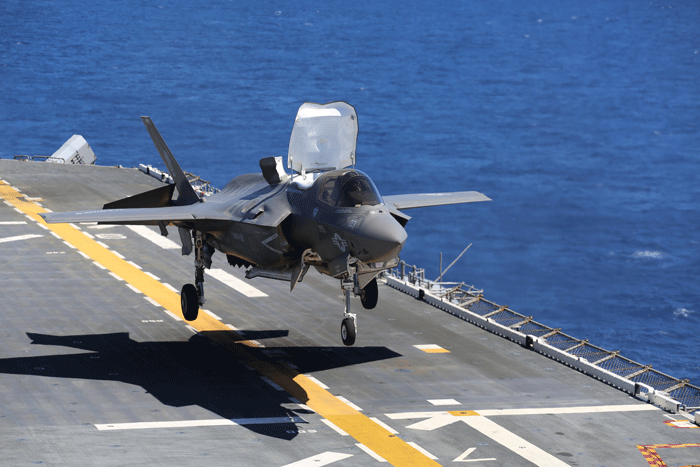2015-06-04 By Robbin Laird and Ed Timperlake
In a meeting last year in the United Kingdom with one of the RAF officers responsible for the introduction of the F-35 into the UK forces, Group Captain Paul Godfrey highlighted the behind the scenes work to roll out an F-35 fleet, an effort largely ignored by the analytical press.
“There are 115 F-35s flying now. We are focused on how we are going to use the capability, not whether it will exist. There is a huge gap between the users of the aircraft and the broader puzzlement over the future outside of the warrior community; we are just getting on with it.
We just need to encourage thinking that isn’t tied to whatever we’ve done in the past. The F-35 fleet is different and can be used for force transformation; unless you don’t.”
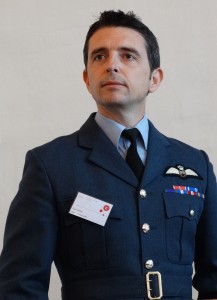
While more direct than most, Godfrey’s comment reflects the reality as seen by those in the U.S. services and in US allied partners involved in bringing the F-35 fleet to life.
The number of airplanes flying is now 140, rather than 115 but the perceived reality among the growing F-35 community is that the future is now.
It starts this year with the USMC and will accelerate through the next three years.
While the Chinese and Russians introduce their “fifth generation” aircraft, the U.S. and its allies are preparing to launch a global fleet.
The Chinese and Russians have client states; the U.S. has allies and what is unique about the F-35 is it is jointly funded and jointly operated by a global coalition.
This simple fact seems to be missed by many.
When 60 minutes did a program on the F-35, not once was it mentioned that this is a global aircraft, not simply an American export.
Recently, the Norwegian Defence Minister opened an F-35 partners meeting held in Norway by this comment with regard to the arrival of the F-35 for the US and the partners: “We’re turning the future into the present.”[1]
Our new Special Report looks at the services and the allies as they prepare to introduce the F-35 into service and look to transform their airpower capabilities appropriate to dealing with 21st century threats.
The report is based on dozens of interviews with the services and partners, ranging from Italy, to the UK, to Australia and from Eglin, to Yuma, to Fallon.
21st century warfare technologies concepts of operations, technology, tactics and training are in evolution and revolution.
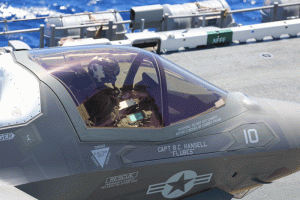
However, there is always the reactive enemy who gets a vote in combat.
Consequently the roll out of new approaches to execute a successful combat campaign being shaped by the impact of the F-35 is critical to understand.
The F-35 is at the heart of change for a very simple reason – it is a revolutionary platform, and when considered in terms of its fleet impact even more so.
The F-35, Lightning II, has a revolutionary sensor fusion cockpit that makes it effective in AA, AG and EW. Allied and U.S. combat pilots will evolve and share new tactics and training, and over time this will drive changes that leaders must make for effective command and control to fight future battles.
An issue has been that the F-35 has been labeled a “fifth generation” aircraft, a sensible demarcation when the F-22 was being introduced.
But the evolution of the combat systems on the aircraft, the role of the fusion engine, and the impact of a fleet of integrated F-35s operating as a foundational element will make the current term “5th Gen” obsolete.
The global fleet of F-35s will be the first generation for building a foundation for a fundamental change in the way air power operates in overall combat concepts of operations. It is not in and of itself a single aircraft platform; it is about what an integrated fleet of F-35s can deliver to TRANSFORM everything.
The decade ahead will be very innovative if what the fleet brings to the fight is learned and applied.
Combat warriors, at all ranks, can leverage what they learn and then apply those lessons to reshaping the force over and over.
The F-35 is entering service at an interesting time in the evolution of digital warfare.
The US and Allied fleet of F-35s will also add an “electronic” or “tron” warfare component to the fight, an “E” for electronic.
It is not necessary to designate the F-35 as the F/A/E-35 but that would be more accurate.
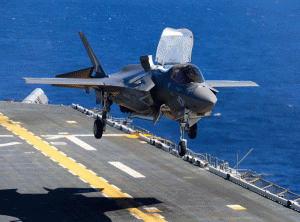
Because of the growing role of shared situational awareness and shaping of what some are calling the “combat cloud”, tron warfare is part and parcel of the transition in air warfare. Tron warfare is about protecting your ability to operate in shared communication space and to deny your adversary the ability to do so.
To put it another way, the F-35 fleet allows the air services to shape a new foundation for engaging in active and passive Tron Warfare, but because “no platform” fights alone can be a foundation from which other elements of the airpower and combat capabilities are woven in for 21st century operations.
In other words, the IOC of the F-35 is not simply about the introduction of a replacement aircraft but the next phase in the revolution of airpower and inextricably intertwined with doing air combat differently.
In discussions with the pilots, maintainers and industrialists involved in the launch of the F-35, there is clear awareness that the F-35 is not simply about business as usual. There is a clear sense of excitement seen by the F-35 launch cadre, which is missed by those not part of the process.
And each service or partner has a particular launch point with regard to transformation, which the F-35 enables or facilitates.
This is not a replacement aircraft in and of itself, but rather it is the driving technology catalyst for a transformation of combat air power in this next phase of military aviation history.
The roll out of the F-35 global fleet through the iterative IOC process lays a foundation for crafting 21st century joint and coalition approaches to air and combat power.
Built into the IOC of the F-35 roll out is a nascent global fleet. Again it is not about the IOCs of a single platform for a single service, it’s the concurrent roll out of U.S. and allied F-35s.
And this roll out is supported and facilitated by a collaborative cadre of pilots, maintainers, and industrialists worldwide.
For the US services, this means being joined at the hip about the way ahead for the F-35 community.
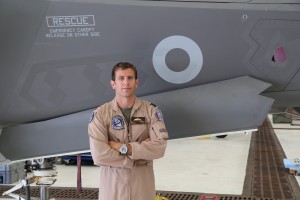
For the allies, this means engagement with the U.S. service’s “F-35 cadre” as they roll out their capability as well.
Indeed, there are two key lines of collaboration shaping the roll out.
The first is the training cadre based at Eglin, Luke and Beaufort where pilots are trained to fly either the F-35A, or B or C.
Luke will become the center for excellence for the roll out of US and allied F-35As; with Beaufort becoming the initial training base for the roll out of US and allied F-35Bs. The Navy is currently training at Eglin, with its first squadron of F-35Cs, the Grim Reapers.
The second key collaborative effort is shaped by the warfighting centers of excellence at Marine Corps Air Station, Yuma, Nellis AFB, and Fallon Naval Air Station.
The F-35 community at all three warfighting centers is working together to think through how to use the F-35 as it comes into the fleet.
F-35 partners are visiting the centers as well, such as a recent visit of the Royal Navy and Royal Air Force officers to Fallon.
It is this community of warriors, which is shaping the roll out of the F-35 global fleet.
The commander designate of VMFAT-501 at Beaufort, Lt. Col. Summa, described the process, which as Executive Officer of Marine Corps Squadron VMF-121, he was experiencing:
“We are working with the USAF at the 422 Test and Evaluation squadron at Nellis. We tend to busy here, so we send operators from the training department or former patch wearers (MAWTS-1 and TOPGUN) to work with SMEs from the Navy and USAF at conferences or simulator events.
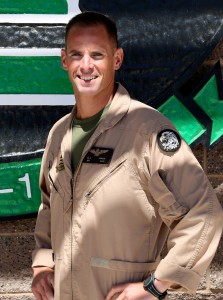
The young senior company grade who are coming off of a tour with a Hornet or a Harrier and now wearing a Green Knights patch go into the room with the aviators at Nellis with F-16 and F-15 pilots and work through the process.
In effect, an F-35 enterprise is emerging built around a group of individuals in the profession of arms who want to make this airplane as lethal as possible.
People come in from different backgrounds – Raptor, Eagle, Viper, Hornet or Harrier – and are focusing on the common airplane and ways to make it work more effectively in a tactical setting. And talking to the experience of a common plane is a crucial piece of the effort.
When an F-35 pilot sits down regardless of what service he is in, he’s talking with an individual from another service on the same data point….If we differ in training, it doesn’t have to do with hardware, it doesn’t have to do with software; it has to do with service approaches or carry-over from previous doctrinal employment.
When an F-35A pilot talks with an F-35B pilot and they discuss what they would to see with the evolution of the aircraft they are discussing essentially the same airplane and its evolution.
It is two operators of the same airplane focused on what they want to see evolve even though they are in different services. And the commonality point is really lost in the broader discussion of the F-35. And when it comes to strategic impact it is the commonality associated with logistics, which will have a really significant operational impact.
The interoperability at the supply level, the logistics level, the procurement level or the maintenance or training level is a key foundation for joint and coalition airpower going forward leveraging the F-35”
It is inevitable that the joint services and the coalition partners are clearly going to find significant commonalities and ways to work together going forward from the process of figuring out how collectively to use their F-35s within their service or partner operational cultures.
And this is facilitated by the common cockpit information systems within the fleet. One little noted commonality is the common symbiology in the cockpit.
All pilots will have uniformly understandable symbols and cockpit display icons that are not language specific.
The common icons and graphics can be understood correlated with evolving combat experience, in the fighter, attack and electronic warfare mode.
This represents a dramatic shift from the past.
For the first time in history, individual F-35 pilots –A, B or C – will have the best database of real time knowledge in the history of combat aviation.
And all of this is internal to their cockpit and enabled by advances in computer processing and sensor information fusing.
The USMC and the smaller partner air forces due to their size will find very innovative ways to leverage their F-35s within their operational situations.
The USAF as the largest user of the F-35 will find unique ways to combine F-35s with their other assets in shaping a more effective air dominance enterprise.
And the USN will focus on how the F-35C enables a more effective integrated fire controls integration effort and to empower the evolving integrated air wing and Navy surface warfare ships and their submarines.
Each service and partner will provide ways to think about how the F-35 transforms their approaches; and the sharing of these ways to think will empower the overall joint and coalition combat capabilities for US and allied joint and coalition forces as well.
In other words, rather than thinking of an IOC it is better to focus on rolling out of a global fleet which will help re-shape collaboration and innovation in 21st century air operations.
To download the Special Report, go to the following:
https://sldinfo.com/the-coming-of-the-f-35-the-services-and-partners-get-ready/


